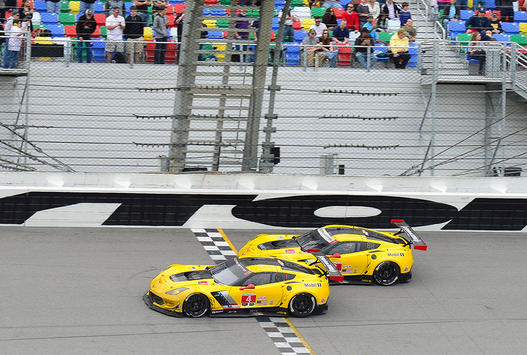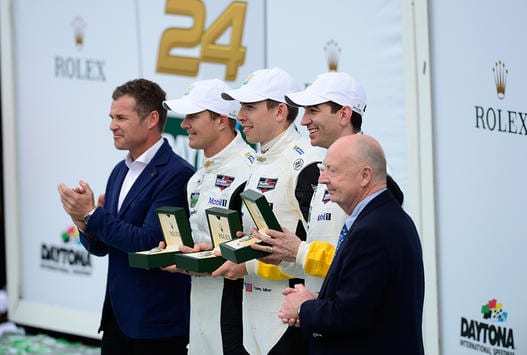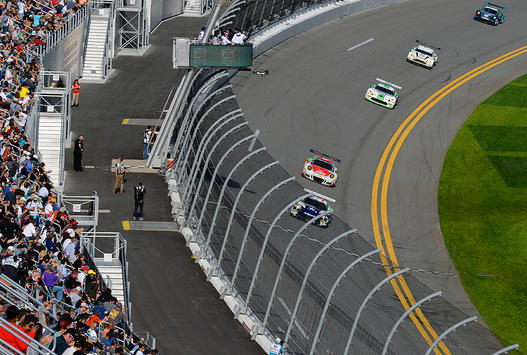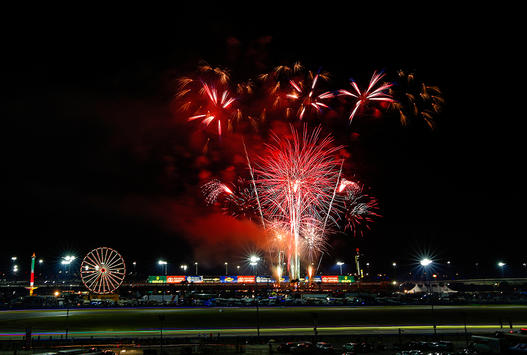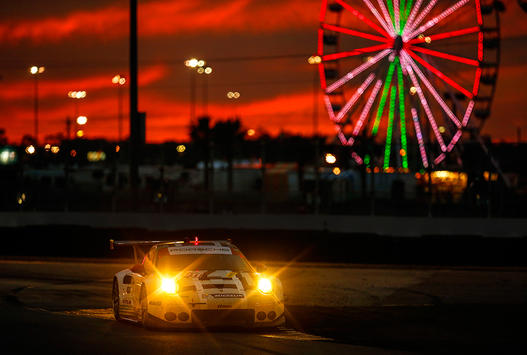
Daytona International Speedway

Gallery
Track History
The history of automotive competition in the Daytona Beach area goes back to 1903. It is recorded that a friendly wager between two gentlemen debating who had the fastest horseless carriage spawned "The Birthplace Of Speed." The wide, hard-packed sands of "The World's Most Famous Beach" were the scene of nearly 30 years of speed trials. In addition, the 1905 movie "Automobile Races at Ormond, Fla." probably added to the area's draw.
Among the most famous of the pioneers of speed was Ransom E. Olds, later of REO and Oldsmobile fame, who was the first person to race on the beach in a timed run.
The final speed trials were held in March 1935. The trials then moved to the Bonneville Salt Flats in Utah. Daytona Beach had earned a world-wide reputation as "The Birthplace of Speed;" now it needed something to continue that legacy.
Stock car racing on the beach began the following year and lasted until 1958. The sport wasn't new, but racing on a course which combined a portion of the beach and a public road was. Auto racing history was being written on the sands of Daytona. The original 3.2-mile course had the north turn located near the center of town. The course ran approximately 1.5 miles north on the beach and then 1.5 miles south on a paved, public roadway with the two portions connected by banked sand turns.
A local mechanic by the name of Bill France entered the inaugural race on March 8, 1936 and finished fifth. It was the beginning of an era. In two years time, a two-wheeled version of beach racing history began with the inaugural Daytona 200 motorcycle road race on Jan. 24, 1937. The racing was halted during World War II in the interest of national defense. Stock car racing resumed on April 14, 1946. The motorcycle races resumed the following year, Feb. 27, 1947.
France put aside his driving gear at the end of the 1946 season to concentrate on the demands of being a promoter of both stock car and motorcycle races on the beach. Soon after, in December 1947, he founded NASCAR, the National Association for Stock Car Auto Racing.
In 1948, a new beach/road course greeted the racers. Daytona Beach and the surrounding areas were growing. The organizers were forced to move the circuit down the beach toward Ponce Inlet. The new course for the stock cars measured 2.2-miles with a longer 4.1-mile course for the motorcycles. Both courses shared the same south turn.
In 1953, France saw that the days of racing on the beach-road course were numbered due to the spreading land usage of a rapidly growing population and huge race crowds. France put his plan for the future of racing in Daytona into motion on April 4, 1953 with a proposal to construct a permanent speedway facility.
On June 6, 1955, the dream of a speedway in Daytona took on the foundation of reality for the man friends, fans and the newspapers called "Big Bill." A contract between the Racing and Recreation Facilities Authority, created by the city and county commissioners on Aug. 16, 1954, and the Daytona Motor Speedway Corporation, headed by France, was signed to operate the proposed $2,500,000 facility.
The projected opening date for the track was July 4, 1957. It was an optimistic target given the downturn of the economy in the ensuing years, which all but put an end to the sale of bonds to finance the project.
In the end, the renamed Speedway District Commission signed a new contract with France on Nov. 8, 1957, allowing the corporation headed by him to lease the property. Thus, the 1958 race would mark the final time the beach-road course would be used for auto racing.
The search for private funding began immediately, with ground clearing of an area adjacent to the city's airport beginning 17 days later on Nov. 25. The plans called for a 2.5-mile tri-oval-shaped circuit boasting 31-degree banking in the turns. The impressive plans were regarded at the time as blueprints for a marvel of engineering and construction — or a fantastic dream that would never reach completion. The doubters never took into consideration the resourcefulness, drive and determination of "Big Bill."
On Feb. 22, 1959, Daytona International Speedway, the "World Center of Racing," hosted the first DAYTONA 500. The posted awards for the "500-Mile International Sweepstakes" totaled $67,760. A field of 59 cars took the green flag for the start. A crowd of more than 41,000 was on hand to witness the beginning of another chapter in the history of racing in Daytona.
The finish of the race also went into the history books. The finish appeared too close to call, but Johnny Beauchamp savored the celebration in Victory Lane. The results were posted as "unofficial." It took three days to decide that Lee Petty was the winner in what appeared to be a dead heat between Petty and Beauchamp — with Joe Weatherly making it threewide at the finish line, although he was two laps down to the front runners. A clip of newsreel film provided the conclusive evidence that Petty was the winner — by approximately two feet!
The Daytona 200 motorcycle race continued to be run on the beach through 1960. In 1961, the Daytona 200 moved to the Speedway.
In 1962, the Speedway hosted the inaugural running of the Rolex 24 At Daytona sports car race, which was then a three-hour race known as the Daytona Continental. The event was won by Dan Gurney in the Arciero Racing No. 96 Lotus- Climax 19B. Gurney held a one minute, 40-second lead in the final moments of the race when his engine blew.In order to win the race, Gurney realized he would have to cross the finish line after time expired. If he crossed the line before the three hours were up, he would have to run another lap, which he was unable to do. Gurney waited on the high groove of the 18-degree banked tri-oval and when the watch struck three hours, he coasted the final five feet to take the checkered flag and the win.
The Rolex 24, which is known today as America's most prestigious sports car event, became a 2,000-kilometer race in 1964 and then a 24-hour race beginning in 1966.
